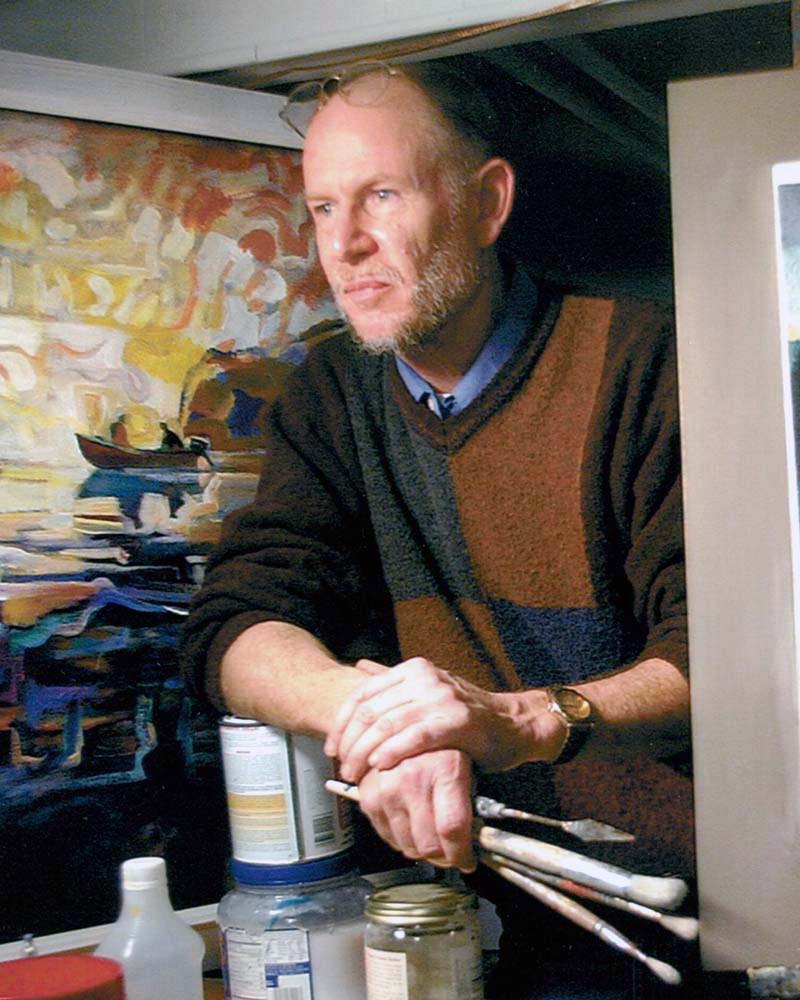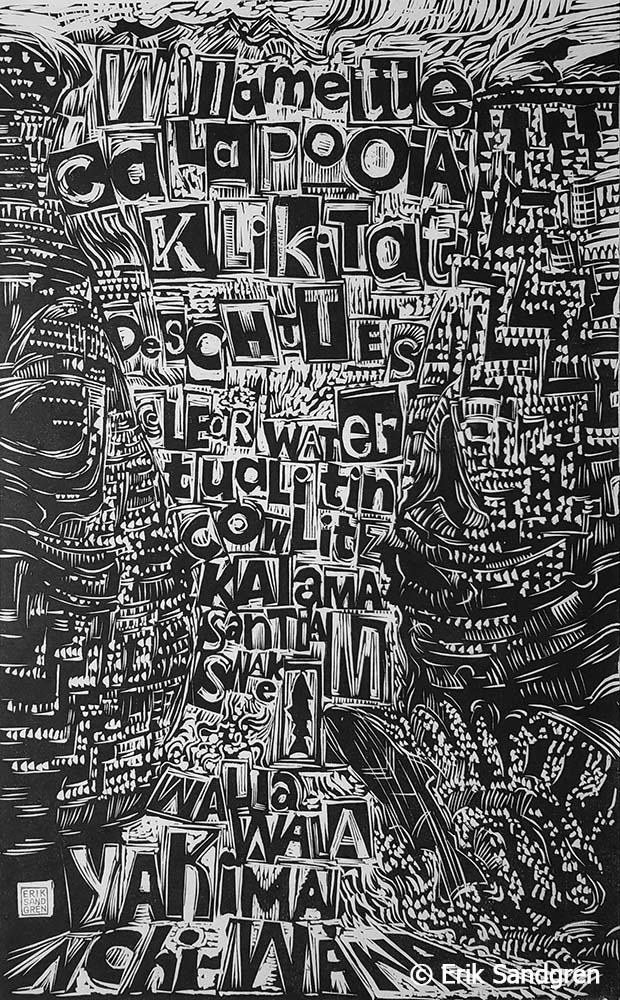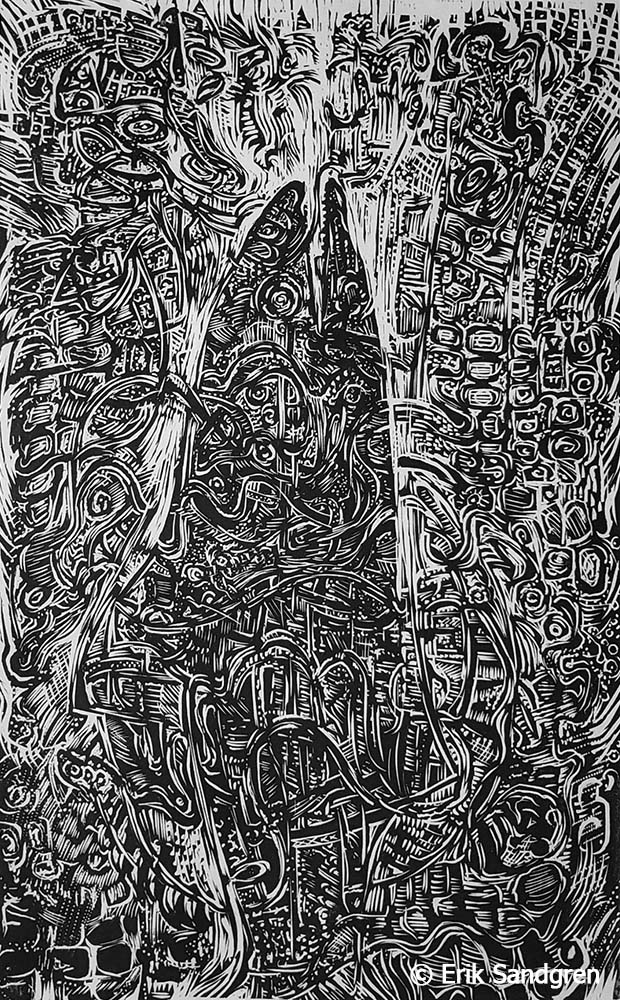 Erik Sandgren is a Northwest Artists Against Extinction collaborating artist whose work has made an impact on PNW visual arts culture. The mountains, skies, water, trees, and the people of the region have provided inspiration for his works which resonate with themes of location, memory, and myth.
Erik Sandgren is a Northwest Artists Against Extinction collaborating artist whose work has made an impact on PNW visual arts culture. The mountains, skies, water, trees, and the people of the region have provided inspiration for his works which resonate with themes of location, memory, and myth.
Britt Freda, creative director of Northwest Artists Against Extinction, a project of SOS, recently interviewed Erik Sandgren on his upcoming exhibitions The Columbia River: Wallula to the Sea and King Salmon: Contemporary Relief Prints.
Britt Freda: “Erik, it was so nice to talk with you about your upcoming exhibition(s) at Maryhill Museum in Goldendale, WA. The title of the show is The Columbia River: Wallula to the Sea with a companion exhibit King Salmon: Contemporary Relief Prints. Will you explain more about the origins of the exhibits, and how they came to fruition?
Erik Sandgren: This exhibit represents the cultural dynamic and physical realities of the Columbia River from Wallula to the Sea. I’m honored to have been selected to produce work for the show. I have seventeen pieces of the seventy final selections, additional works were commissioned by contemporary artists, and quite a few pieces borrowed from collectors and institutions, as well as from Maryhil’s permanent collection. The diversity makes for an engaging exhibit. It touches on so very many frames of reference.
The companion show comprises contemporary prints representing King Salmon. I’m pleased to be in this one also, with black and white woodcut prints. Together they are the brainchild of Maryhill’s Curator of Art, Steve Grafe. Manifesting his vision over the last decade, these shows respectfully ground the museum collections, exhibits, and programming in the Columbia River Plateau.
The Friday night opening is an RSVP $50 event for non-members. The exhibitions are open all day on Friday until 5:00 and on Saturday until 5:00 too.
BF: You mentioned painting along the Columbia River over a two year period for this exhibit. That sounds like an incredible way to gather source material and inspiration! Say more about that journey and what that creative experience meant for you as an artist, an environmental advocate, and as a human being.
ES: Well, part of the inspiration was in the confidence of the curator to commission work based on his evaluation of my track record as a painter and then NOT stipulate what needed to be painted. I plunged in by visiting places I hadn’t been previously, revisiting some favorite locations. I plagued Astoria historian and songwriter Hobe Ktyr for historical information and we poured over maps and place names as he expanded my acquaintance and corrected my misinformation about the River. Hobe sent me digital versions of Cleveland Rockwell’s gorgeous 19th century charts with topographical additions and I began to get a better idea about the lower reaches of the River and all the changes that beavering industry has made to its margins in the last century or so. This was all on top of a couple decades of painting the Columbia here and there from my perch in Aberdeen Washington while delving into Native American cultures and accounts of early [European] explorers, trappers, and settlers.
BF: In our conversation, you talked a little bit about collaboratively creating the narrative for the exhibit through the writing and pairing of “captions” to the images. I am curious to know what the broad focus was for writing the captions. Are they teasers or leads into a bigger story? Can you give us an example with an image of a work and caption that is in the exhibit?
ES: At least four people are doing the captions and mine are mostly collaborative - not only so the facts are correct. The history and significance of a place informed many of my choices of sites and painting experience. I also let my painters’ instinct for place choose the situation and some of them were later found to contribute in some way to the global narrative about place, history, and prehistory. Some locations just speak to me–not as just a view, but with some kind of sympathetic resonance. Some places have a lot going for them. A painting might be about the vantage point as much as what might be seen from there.
I’m friends with one of the members of a Surfer band, the Ultronz of the 1980’s. Through him, I can see the river through the lens of its appeal to those spectacular physical challenges. I smuggled some of the lyrics of Airtime into the captions for [my painting] The Hatchery. I painted there across the river from Hood River. It’s a gorgeous spot with oaks and pines amongst the rocks at water’s edge - and typically layered. It meant so much as an access to the water for the boarders at the time and remains so to the recreational culture that grew up around that, all the while representing the complexities of the salmon industry and fish restoration efforts. This is a single example of the cultural layers that coexist at any spot you choose to explore - meaning embedded in the landscape and the landscape itself signifying these associations.
BF: Aside from the information we’re sharing here in our conversation, you mentioned the opening reception at the Maryhill Museum with Curator of Art, Steve Grafe. If people are in the Goldendale/Maryhill area Friday, March 15 from 5:00 - 7:00 what can they anticipate from this event?
ES : This will be a concise introduction to the curator’s overall vision for the show and conversations with a few artists about some representative pieces. Also a chance to meet and acknowledge the people who make this happen
BF: I love that your expansive body of work inspired a Salon de Refusés, otherwise known in English as an Exhibition of Rejects! Is that a separate exhibit that will show while Wallula to the Sea is hanging, or is the only day to view the work Saturday, March 16 at the lecture from 2:00 - 4:00?
ES: Steve will speak to the variety of work from many artists he considered for the show. It will be very revealing to have a look at the things he might have considered were there even more exhibition space. This is his opportunity to share a broader and even more inclusive conception of his understanding of the river and its cultural dynamics over the last two centuries. There are a lot of really interesting and compelling pieces that were left on the cutting room floor, so to speak.
BF: The exhibit is on view from March 15 - November 15, 2024. Beyond visiting the Maryhill Museum, and spending some contemplative time near the Columbia River, are there other “must-sees” or “must-dos” you recommend people don’t miss while in the area?
ES: Walking about the Klickitat River gorge a couple of miles up from Lyle is always an inspiration for me personally. I also like the trails at Catherine Creek a few miles downriver from Lyle - especially when Camas is in bloom during April. In fact, leaving the River for a few miles inland, by car or foot is always a revelation. Big as it seems, the Columbia River is dwarfed by its drainage. Always a shock to appreciate from up high–the rugged landscapes it traverses. You get an awesome sense of the enormity of the Shield lava flows and the Missoula Flood cataclysms that shaped the landscape we are familiar with in this little spot of time. There’s something for every visitor, from art to wine to sailboarding and many worthwhile historical markers for clues to our collective history. The Gorge Discovery Center and Museum near the Dalles and the Columbia Gorge Interpretive Center near Stevenson provide good context.


Woodcuts by Erik Sandgren
